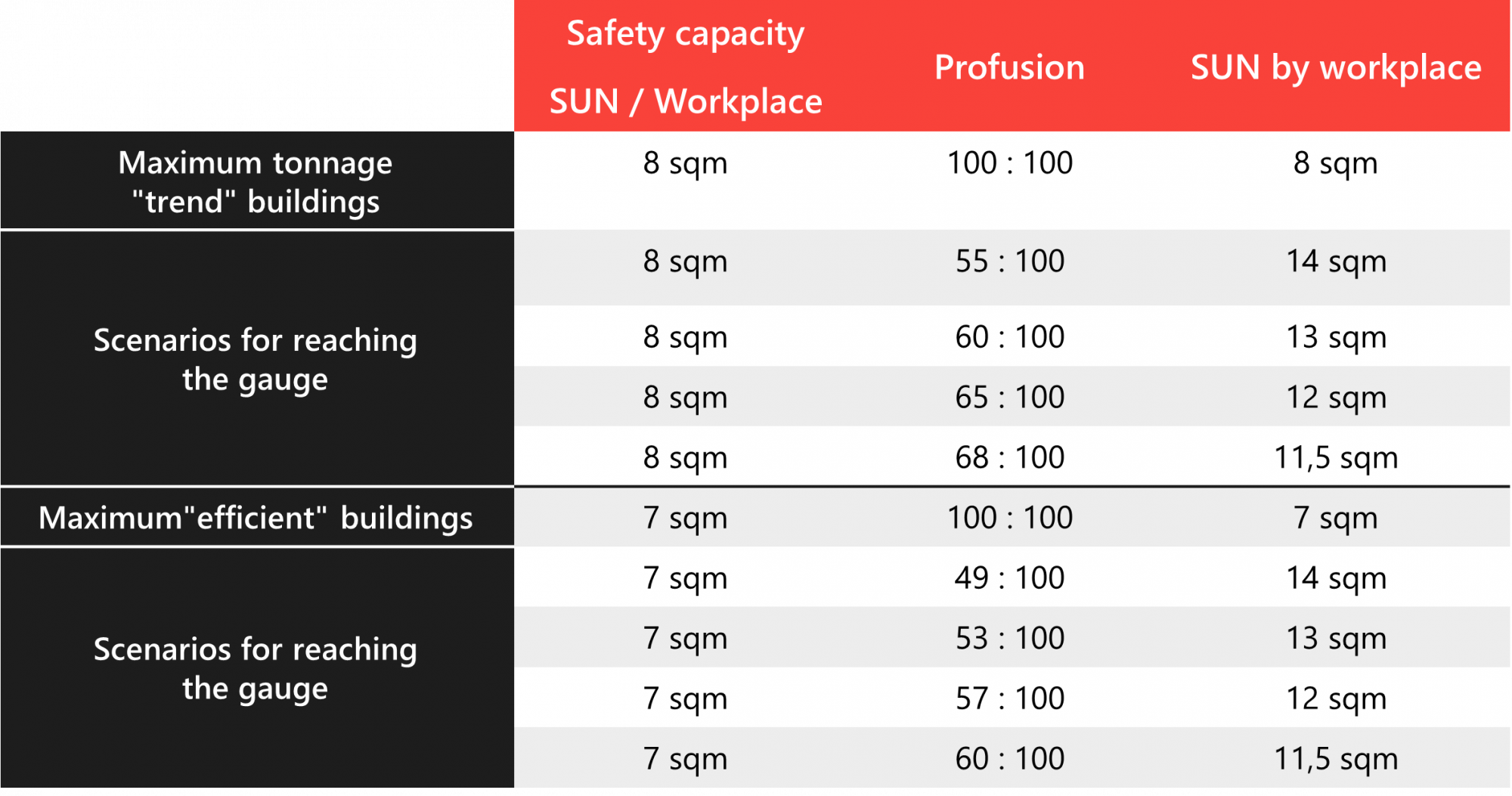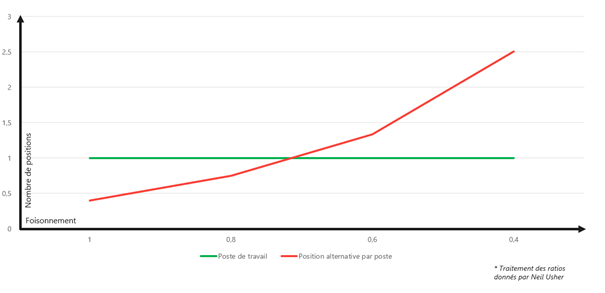- Home
- EN
- Our impact
- ProspeKtive
- The hybridization of work facing the tertiary park

The hybridization of work facing the tertiary park
October 2021
Expert
In cases where hybrid work is massively deployed, the subject of optimizing the workspace goes beyond the usual issues of space occupation. After a certain expansion (or sharing rate), the installation of gauges is necessary to guarantee the safety of the occupants. The diversification of spaces required by hybrid work is not compatible with all buildings. Digital is a tool for regulating arrivals and streamlining uses.
The development of remote work has created a hybridization of work, which is the result of two hybridizations which are themselves intertwined. That of the workplace (working at home, in a third place, in the company, etc.) and that of the modes of exchange (physical, digital, mixed; synchronous and asynchronous). These new uses question the essence of the office and strengthen its role as facilitator. Passenger within teams, between teams, knowledge, etc. with the aim of creating value. For some professions, the fact of working remotely has an impact on the organization of work: individual tasks are rather carried out remotely, those more collaborative face-to-face. For others, hybridization does not fundamentally change the organization of work. A profile whose work is characterized by planned collaboration activities will make them either in the office, or remotely, or even in a hybrid fashion.
Since a significant part of the hybrid work is done outside the walls, the question of the occupation of space is even more important than before the health crisis. Is it relevant to provide each employee with an individualized workspace if they are only present half the week? How to meet the growing needs for collaboration spaces? Flexible accommodations are a response to these two challenges. In their philosophies, the surface allocated to workstations is reduced while collaboration spaces are increased. Since the health crisis, more and more employees understand the interests of this type of solution, being aware that their working methods have evolved. At the same time, real estate, general, financial and human resources departments are interested in implementing this new workplace equation.
The goal is to rebalance the spaces in relation to the needs by increasing the share of collaborative spaces and by reducing the surfaces. Some target ratios of 70% of square meters dedicated to collaborative / 30% to individuals; while aiming for significant surface optimizations (up to 50%). These optimizations are achieved by increasing the number of registrants on the same site or by rendering surfaces when possible.
A whole engineering is put in place to estimate the needs of the hybrid worker. How many days of telework are authorized? How? What are the employees' intentions? Managers? How will telework be organized? What are the planned on-site and off-site activities? These elements make it possible to establish space programs taking into account the specificities of each entity. The first feedback shows an evolution in the way in which these new environments are conceived. The more work is done outside the walls, the more the size of the workspace is disconnected from the number of employees. This does not mean that special needs are no longer taken into account. This means that, beyond a certain threshold, the number of employees attached to a site has less and less influence on its programming.
Depending on how hybrid work is set up, this threshold is more or less 3 days of teleworking per week. Beyond this threshold, teams tend to completely dematerialize their tasks and processes. Those who still need to come to the site organize hotlines with rotations. For trades for which this is not possible, the three-day threshold is rarely crossed. The size of the site also influences the determination of this threshold. Adding 300 employees to a site of 3000 is not the same as adding 100 to a site of 300; the balances are not impacted in the same way. By deploying hybrid work on a massive scale, thinking about the work environment is no longer to determine flex office modalities (number of workstations per employee or expansion) but to create ecosystems that meet the needs of employees on site - which leads to the logic of 70% distribution of collaborative surfaces; 30% of individual surfaces. In this logic, the workstation is no longer a work unit giving a lot of meaning, it is better to count the work positions (the workstations and sets of alternative places where it is possible to work).
Beyond all considerations on taking into account the needs of employees, the observation that sizing is decorrelating from the number of registrants also stems from the constraints induced by the very design of tertiary buildings. Indeed, as soon as there is an increase of 50 to 60 workstations for 100 people, the security capacities (more particularly fire) of the buildings tend to be exceeded. In other words, it is not legally possible to accommodate all registrants simultaneously on the site.
The table below gives benchmarks on the maximum expansion and associated areas per station from which it is likely that the gauge will be exceeded. Two scenarios are presented: so-called “trend” buildings, which correspond to most of the buildings studied to make this simulation, and “high-performance” buildings, which are often recent projects intended to be marketed in multiple tenants and with surface areas. relatively small dividers (less than 1000 m²). For the first buildings, the security capacity is frequently sized at around 8m² per person on site. For the latter, it is around 7m². Before going any further, it is interesting to note the capacities are oversized for arrangements allocated or shared workstations as they were done pre-crisis, even in the most innovative scenarios (expansion close to 65: 100). Each expansion is indicated one area per station. The greater the expansion, the more surface area per workstation increases: the number of workstations changes inversely with the number of collaborative positions. In these scenarios, the notion of workstation is an input, what matters is the number of associated employees. Thus, all these scenarios assume the same number of employees on site simultaneously - this number being set by the safety capacity.

From the moment it is accepted that the gauge will not be exceeded, the sizing of the expansion will depend on the ecosystem that we want to create for the employees present on site and no longer directly on the number of employees attached to the site. . Will we want to offer them a very collaborative environment? It might be tempting to say yes, but our research has shown that a good portion of the profiles who return to the office in hybrid mode will all be relatively sedentary. In this case, for these populations, the expansion to be retained would be lower (for example 60: 100 against 50: 100 for more nomadic profiles within the company). Making this choice in conscience requires knowing all the working methods and making groupings by similarities.
Thus, displaying an abundance of 30: 100 indicates that only a part of the registrants will be able to go to the site simultaneously. The effective expansion for the occupants at time T is higher, greater than 55: 100 in the majority of cases. Benchmark and usage projection studies make it possible to make trend projections to determine the different work positions to be implemented according to the chosen expansion. It is commonly accepted that the more positions are shared, the more alternative positions are needed. The English consultant Neel Usher considers that, whatever the case, there should be 1.4 positions per person: if there is one position per employee, 0.4 positions should be provided in meeting rooms and alternatives. ; if there are 0.7 positions per employee, it is 0.7. In his guide to Activity Based Working, Juriann Van Meel gives slightly different ratios but using the same logic.
Thus, with expansion of 40: 100 (0.4 position per employee), it would therefore be necessary to provide 1 collaborative position per registrant; or 2.5 alternative positions per workstation. This proposal may make sense for very collaborative professions and will have its limits for sedentary professions. It also poses serious technical challenges. In this type of 40: 100 scenario, the surface area that should be allocated to closed meeting rooms frequently exceeds 30% of the floor space; whereas in the majority of tertiary buildings the surface area available for meeting rooms rarely exceeds 15% (some more recent buildings allow 20% to be allocated to meeting rooms). Technical solutions such as variable flow HVAC adapting to space occupancy exist to compensate for this limitation, but they cannot be deployed in all buildings. Self-contained bubbles are another workaround. Finally, other proposals, such as setting up open or semi-open meeting rooms, are explored. In these latter cases, particularly fine work must be carried out on the acoustics in order to guarantee good user comfort.


Once the ideal expansion rates are established (per registrant and per user simultaneously), that the desired types of spaces are technically feasible, it remains to establish the acceptability of such projects and allow their daily operation. Here, digital is a solution; some even tend to make it THE solution. Digital solutions make it possible to manage arrivals and ensure that the gauge is respected, in particular via registration systems and capture of the number of users present in real time. They also facilitate the daily use of spaces, provided that the data is reliable and correctly used. The first feedbacks also challenge the idea that the greater the abundance, the more spaces should be reserved. On the contrary, the more diverse the spaces, the more flexible their management should be. Finally, the data collected makes it possible to monitor the use of spaces while adjusting supply to demand in a logic of continuous improvement. Digital is therefore a good solution for the operation of sites. But the applications, the sensors and the data collected do not solve the main problem posed by these work environments where free attendance is no longer the norm: how do collectives cope with these new ways of doing things?
And besides, from a human point of view, is this type of work environment desirable?
Release date: October 2021




